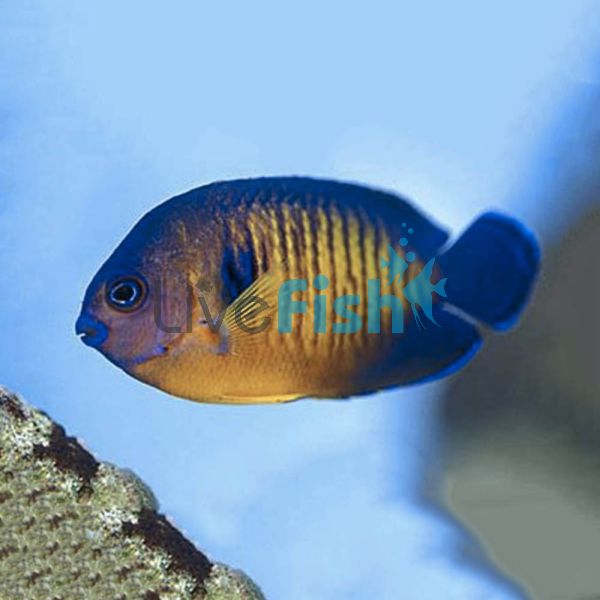Coral Beauty Angelfish - Medium
The Coral Beauty can grow up to 4" (10 cm), has a lifespan of around 12 years. Coloured red or orange with thin vertical striping in a darkish blue. There is a purplish-blue over the head, face and fins with a blue-edged orange-red spot at the base of the pectoral fin. Colouration and patterning do vary depending on where they originated. With variations on how vibrant the colours are and what shades of purple and reddish-orange they have.
Coral Beauty Angelfish
It has the standard dwarf angel shape with a small elongated oval-shaped body, with rounded fins. The Coral Beauty can grow up to 4" (10 cm), has a lifespan of around 12 years.
Coloured red or orange with thin vertical striping in a darkish blue. There is a purplish-blue over the head, face and fins with a blue-edged orange-red spot at the base of the pectoral fin. Colouration and patterning do vary depending on where they originated. With variations on how vibrant the colours are and what shades of purple and reddish-orange they have.
The Coral Beauty may be aggressive toward other fish, but unlike other dwarfs, it doesn't pick on smaller tank mates.
They usually live alone or in small groups consisting of one male with 2 to 5 females.
Two Coral Beauty males in a small tank will fight to the death. If you want to have 2 males in a tank it will need to be well over 100 gallons with plenty of hiding places for both.
The male is generally larger than the female, but the colour is not a sign of the sex.
These fish are all born as a female, then as they grow in a group, the larger and more dominant fish will become male and the others will remain female.
If the male disappears, then the next dominant female in the hierarchy will turn to male. Putting a larger and smaller fish together is the best way to get a pair, which usually takes about two months.
These are very hardy fish, resistant to disease and generally good eaters which makes them ideal for beginners.
They live from East Africa to Tuamoto Island and Izu Island and south to Lord Howe Island in the wild.
In the wild, they prefer lagoons and reef slopes with plentiful coral growth and algae.
Tank Recommendations for the Coral Beauty Angelfish
The Coral Beauty like the larger angelfish intelligent and only tends to cause problems if kept in a smaller tank. Where it can feel it must defend its territory.
If kept in a spacious community aquarium with fish of a similar size and disposition with lots of hiding places it is will be well behaved.
Live rock with lots of cracks and crevices supply a natural food source as well as hiding places for them. This will help them to feel secure enough to come out.
They do appreciate areas of rubble rock substrate with algae growth and other edibles to feed on.
As with most angelfish, it is best to introduce the Coral Beauty last into a mature tank.
In sparsely populated 55 gallon tanks they do well, but they do best in 75 gallons or larger tanks. This will bring out their easy-going personalities and they’ll ignore corals and other fish usually.
Suitable Tank Buddies
This fish is easygoing for an Angelfish and also doesn’t pick on smaller tank mates as most Angelfish do. They will peck at clams and polyps, but if kept well fed are compatible with many aquarium setups.
Usually Compatible
It's recommended to keep them with other semi-aggressive fish such as Tangs, large Angelfish, large Wrasses and Damselfish. Starfish, shrimps, crabs and snails are all safe to keep with this fish too. Leather corals and most soft corals from the genus Effatounaria are also fine.
Sometime Compatible
In larger aquariums over 55 gallons then you can keep them with peaceful fish too like Gobies, Dartfish and Fairy Wrasses. To keep a male/female pair together this should be in larger tanks (over 75 gallons).
Rarely Compatible
The Coral Beauty doesn’t mix well with slow swimmers or feeders like Seahorses, Pipefish and Mandarins. They are also not suitable to mix with any predatory fish that would be large enough to eat it, such as a Lionfish.
Feeding Your Coral Beauty Angelfish
The Coral Beauty Angelfish is an omnivore. In the wild, it feeds on algae, but it will also ingest tiny animals living in the algae.
In captivity, their diet will be algae growing on live rock. You should also feed them different types of fresh and dried marine algae in flake and pellet form. They will also like live foods like mysis shrimp and brine shrimp. You can also feed them shaved shrimp, spirulina and shredded fish.
| Scientific Name | Centropyge Bispinosa |
|---|---|
| Care Level | Easy |
| Common Names | The Coral Beauty Angelfish, is also known as the Two Spined Angelfish and Dusky Angelfish. |
| Diet | Omnivore |
| Fish Family | Pomacanthidae |
| Lifespan (years) | 12 |
| Max. Length (cm) | 10 |
| Min. Tank Volume (l) | 208 |
| Origin | Indo-Pacific |
| Reef Safe | With Caution |
| Sociability | Semi-aggressive |
| Venomous | No |
| Water Conditions | 21 - 28°C, dKH 8-12, pH 8.0-8.4, sg 1.023-1.025 |




